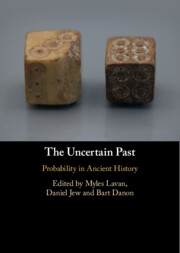Book contents
- The Uncertain Past
- The Uncertain Past
- Copyright page
- Contents
- Figures
- Tables
- Contributors
- Acknowledgements
- 1 Probabilistic Modelling in Ancient History
- Part I Uncertainty
- 2 Assessing the Scale of Property Confiscation in the Ancient Greek World
- 3 Senators and Senatorial Wealth at Pompeii
- 4 The Roman Coinage under the Antonines Revisited
- Part II Variability and Missing Data
- Index
- References
4 - The Roman Coinage under the Antonines Revisited
An Economy of Silver, not Gold*
from Part I - Uncertainty
Published online by Cambridge University Press: 18 November 2022
- The Uncertain Past
- The Uncertain Past
- Copyright page
- Contents
- Figures
- Tables
- Contributors
- Acknowledgements
- 1 Probabilistic Modelling in Ancient History
- Part I Uncertainty
- 2 Assessing the Scale of Property Confiscation in the Ancient Greek World
- 3 Senators and Senatorial Wealth at Pompeii
- 4 The Roman Coinage under the Antonines Revisited
- Part II Variability and Missing Data
- Index
- References
Summary
This chapter presents a new estimate of the value of coinage in circulation in the mid-second century CE Roman empire. More than 25 years ago, Richard Duncan-Jones revolutionized ancient economic history by offering a first projection through numismatic and statistical methods. At more than 20 bn sesterces, his estimate implied an anomalously high monetization ratio given past and current estimates of Roman GDP, an issue that economic historians have had to deal with ever since. In the first half, a review of the numismatic evidence points to a much smaller role for gold than posited by Duncan-Jones. The second half presents a new model of the money supply. It uses Monte Carlo simulation to estimate the value of centrally-minted precious metal coins produced annually under Hadrian, and then the total coinage in circulation ca 160 CE. Allowance for various uncertainties and other, minor components of the coinage suggests a money supply of around 16 bn sesterces, with less gold and more silver than expected. However, this is not quite low enough to explain away the monetization ratio, implying a higher GDP and more trade-oriented economy than currently thought. Two appendices contain lengthy but essential technical discussions of the assumptions in the estimate.
Keywords
- Type
- Chapter
- Information
- The Uncertain PastProbability in Ancient History, pp. 135 - 194Publisher: Cambridge University PressPrint publication year: 2022
References
- 1
- Cited by



